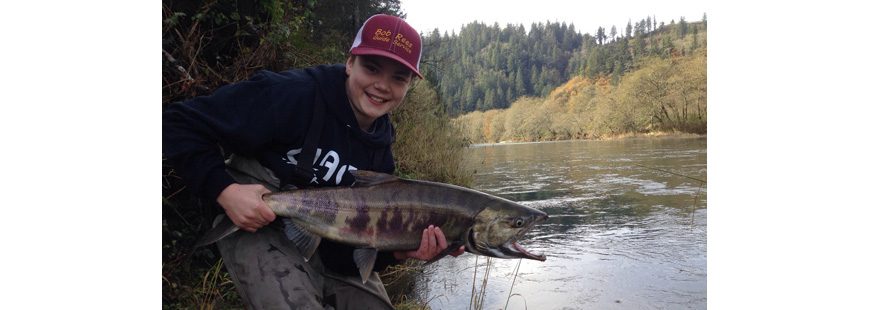Photo: Jackson Curran with a colorful Kilchis River chum salmon from October 22nd, 2016
Chum salmon remain the big question mark in my opinion. As you’ve likely heard me gripe about before, when I first entered the professional field of pursuing fish (I’m a 20-year fishing guide), chum salmon were one of the first wild fish that sport anglers lost access to. I can’t say that was necessarily a heart-breaker for me, since their flesh is of relatively low quality, but I just added it to the long list of other wild salmon species we got shut off from in a short ten-year period beginning in the early 1990’s.
Wild spring Chinook, wild coho, wild cutthroat trout, wild steelhead and wild chum, all closed for retention and regulations so strict, it made you think twice about even going salmon fishing for fear of hooking one of these protected fish. Our Oregon Department of Fish and Wildlife even had it “in the books,” that you couldn’t use colored beads on your gear, for fear that you’d attract one of the last remaining wild coho when pursuing fall Chinook along our entire coastline!
Well, while on my soapbox talking to policymakers, I pointed out the one common denominator in the demise of most of our wild salmonids: lethal summer water temperatures in all of our watersheds. Fall Chinook and, to my surprise, chum salmon, are the only two species of the six runs of fish that don’t require over-summering in our watersheds as part of their early freshwater life history. I could understand why fall Chinook were faring so well, they over-summer in the estuary, where cool ocean waters don’t cause undue stress on them during a time of the year when most species flourish. But why chum? They migrate down into the estuary by March and forage for a little while before heading to the ocean in the spring time. So why are their numbers depressed? I wish someone had an answer.
If chum are so worthless from a consumptive perspective, why do we really care what happens to them? I know that’s not what most anglers and conservationists think, but given what little attention they’ve received since it became known that their numbers were depressed, it would seem they’ve been “kicked to the curb.” Have you ever seen a comprehensive conservation management plan for Oregon coastal chum salmon? Yeah, it doesn’t exist. I guess ecosystem based-management has yet to take full root.
Chum, like ANY aquatic and terrestrial species, are part of the ecosystem. Break the critical link between chum and their traditional role in that ecosystem, and you’ll have consequences somewhere. I started to see where that chink may be when I helped out on a fish use study of Tillamook Bay a long time ago. We happened to be running a seine net around different habitat types on Tillamook Bay, and came across a cobble stone substrate near a popular fishing spot called the Ghost Hole. This happened to be in May, when the spring Chinook were running pretty good too. After deploying the net, I always got a bit excited to see what we would dredge up. (I didn’t even have to bait a hook to catch these fish!) To our amazement, up came a large number of beautiful sea-run cutthroat trout, and even a few sub-adult steelhead. What were they doing here? Well, they were feeding on chum fry.
This is just another example of how a food web works. It’s much more challenging to get a grip on this since our favorite species are underneath the surface, out of visible sight. You don’t ever see a NatGeo film of a cutthroat or coho smolt voraciously feeding on chum fry. Just those poor defenseless deer going down with a cougar wrapped around its neck. The lesson learned here, out of sight, out of mind. We just can’t afford to bury our heads any longer.
And, just as the cutthroat were having a hey-day with these chum fry, so were the coho smolts, but they happened to be freshly listed under the Endangered Species Act at the time. With wild coho on the brink of winking out after a few years of bad ocean conditions, hatchery coho likely made up the bulk of the abundance in the estuary when they migrated out in mid-April. Although I’m still biased towards the tasty coho, I couldn’t help but feel sympathy for those depleted chum salmon fry as they too were struggling for a place in our watersheds. Although there have been some studies on these predation rates, I’m not one to give the wild fish conservancy any additional reason to sue to close down hatchery operations. If we didn’t have hatchery fish, we’d likely not have any fisheries.
The bottom line is this, if we don’t start realizing that every living creature is a trigger in our ecosystems, the 6th great extinction will continue to go unchecked, and we’ll have much more to worry about than when we get to go fishing again.


